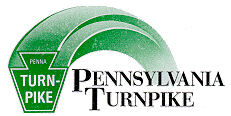 |
Kathy Liebler |
 |
Kathy Liebler |
|
C O M M I S S I O N N E W S R E L E A S E |
||
Contact: |
Carl DeFebo, 717-939-9551, ext. 2934 e-mail: cdefebo@paturnpike.com |
Sept. 28, 2000 |
|
Turnpike Marks 60 Years of Service and Safe Travel HARRISBURG — The Pennsylvania Turnpike arrives at a significant milestone this weekend when the historic toll road turns 60 years old on Sunday, Oct. 1. In the brisk evening of Sept. 30, 1940, long rows of dark, chrome-clad sedans and columns of trucks of all makes and models lined up at the 11 tollbooths — or "ticket offices" as they were called — on the newly built Pennsylvania Turnpike. Motorists were swarming for the chance to be the first on the much-touted roadway that opened to traffic at one minute past midnight, Oct. 1, 1940. Some motorists waited at the bright blue tollbooths for days, and many came from out of state to see what was considered an unparalleled engineering triumph. America’s first superhighway. The dream highway. The all-weather highway. The granddaddy of toll roads. The road to growth. All those monikers have been used to describe the original 160-mile Pennsylvania Turnpike that opened to motorists six decades ago. When it first opened to traffic, the Turnpike ran from Middlesex (near Carlisle) to Irwin (near Pittsburgh). "It broke new ground because it was the first limited-access, four-lane highway with no stoplights, stop signs or cross traffic," said Turnpike Executive Director John Durbin. "It cut three hours off the trip from Harrisburg to Pittsburgh." As it was being built, the focal point of the Turnpike project was construction of seven tunnels through Pennsylvania’s mountains — a feat that was considered, unequivocally, an engineering marvel. Two thirds of the 160 miles were straightaway, and the new highway had no grade more than three percent, thus eliminating the steep climbs and descents associated with cross-state travel of that day. The Turnpike was a transportation revolution largely because of its unprecedented design standards; these engineering principles were groundbreaking in that they considered the comfort and convenience of the driver over the difficulty of terrain or construction method. This was no easy task considering the mountainous terrain with narrow, twisting river valleys on which the road was built. In addition to the spectacular tunnels, many bridges, cuts (manmade gorges) and fills (manmade embankments) were constructed to meet the strict engineering criteria. Nowhere else in the nation was there a road comparable to the Pennsylvania Turnpike. Travelers, mesmerized with the unique concept of long distance, nonstop travel, hopped into their vehicles, picnic baskets in tow, and onto the Turnpike just for the fun of the ride — often without a set destination. The highway forever changed the way Americans traveled — long distances at high speeds, along an entire roadway without obstruction. Indeed, the engineering concepts developed on the Pennsylvania Turnpike were the foundation for a national transportation network that would touch the lives of every American. The Interstate Highway Act of 1956 provided federal funding for a nationwide system of four-lane, limited access highways patterned after the Pennsylvania Turnpike. America’s Interstate Highway Network today consists of 43,000 miles, 2,300 as toll roads. The Turnpike set off an economic boom in small towns in its path, bringing progress and prosperity to places like Somerset, Bedford and Breezewood. During its first year of operation, 2.7 million vehicles traveled the Pennsylvania Turnpike. "During the 1999-2000 fiscal year, 160 million vehicles traveled the highway," Durbin said. "These numbers alone speak volumes about the progress and success of the Pennsylvania Turnpike, whose founders likely could never have conceived such staggering traffic-volume increases." Today, America’s first superhighway is 512 miles long and has evolved into a state-of-the-art information superhighway. Featuring cutting-edge transportation technology, the Turnpike employs an Advanced Traveler Information System, computer-aided emergency dispatching and digital communications — and it will soon launch E-ZPass, or electronic toll collection technology. Since it was first built, the Turnpike has added numerous extensions more than tripling its original length. The extension linking Harrisburg with Philadelphia opened in 1950. Another extension from Irwin west to the Ohio border opened a year later. The next milestone occurred in 1954 when another extension opened to take the Turnpike from Philadelphia to the New Jersey line. The Northeastern Extension — the first north-south section of the roadway that linked the mainline with Scranton — opened in 1957. With the passage of Act 61 of 1987, the Turnpike’s commitment to expansion continues into the present. Three expansion projects opened in southwestern Pennsylvania during the 1990s: the James J. Manderino Highway (Turnpike 43), the James E. Ross Highway (Turnpike 60), and the Amos K. Hutchinson Bypass (Turnpike 66). In recent years, the Turnpike has stepped up endeavors to enrich the roadway through technology. This investment in technology reaches far beyond the collection of tolls: It touches every aspect of Turnpike operations — most importantly, service to and convenience of customers. Initiatives such as the Advanced Traveler Information System (ATIS) that collects and communicates information about traffic and weather conditions and the Turnpike web site (www.paturnpike.com) are visible examples of this investment in technology. Enhancements to the communications infrastructure — like digital microwave technology and a Computer-Aided Dispatch System — are equally as valuable. The engineering concepts developed on the Pennsylvania Turnpike in the 1930s laid the groundwork for a transportation system that would affect every American. As we face the challenges of the digital age, that same pioneering vision continues to prevail at the Pennsylvania Turnpike. When it comes to innovations in transportation, the Turnpike has been and remains on the cutting edge of highway technology. "Today, our commitment to the safety, comfort and convenience of our customers remains as strong and focused as it was 60 years ago," said Durbin. |
||
### |
||
P.O. Box 67676, Harrisburg, PA 17106-7676 Phone: (717) 939-9551 Fax: (717) 986-9649 |
||